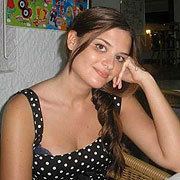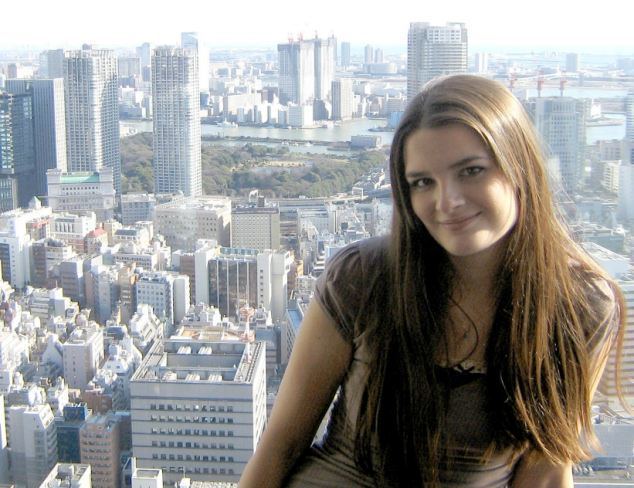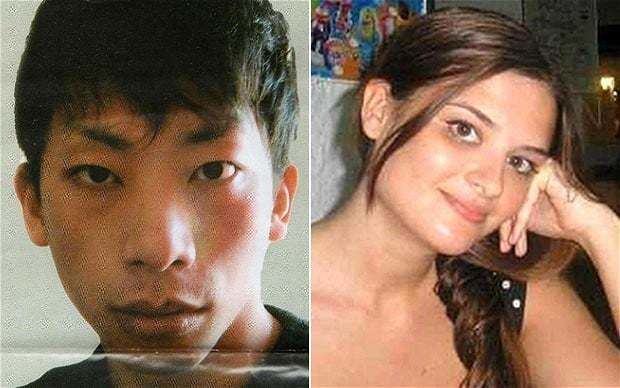Occupation Teacher | Citizenship United Kingdom | |
 | ||
Full Name Lindsay Ann Hawker Cause of death Asphyxia due to suffocation | ||
Lindsay Ann Hawker (30 December 1984 – 24 March 2007) was a 22-year-old British teacher who was killed in Japan in early 2007 by Tatsuya Ichihashi (市橋 達也, Ichihashi Tatsuya), a 28-year-old Japanese man from Chiba Prefecture. Ichihashi was seen fleeing his apartment. Japanese police sought Ichihashi for the murder of Hawker and the abandonment of her corpse.
Contents
- Lindsay Hawker
- Tatsuya Ichihashi
- Meeting
- Events
- Investigation
- Arrest
- Confession
- Sentence
- Media coverage
- Book
- Film
- References

On 10 November 2009, Japanese news media and BBC News reported that Japanese police had apprehended him. On 5 July 2011, Ichihashi confessed to killing Hawker, stating that he smothered her to prevent her from screaming while he raped her. He was sentenced to life imprisonment on 21 July 2011.
Lindsay Hawker

Lindsay Hawker was born to Bill and Julia Hawker, who lived in Coventry, England. She was the second-born of three daughters. Hawker's family came from Brandon, Warwickshire—a village outside Coventry. Hawker was schooled at King Henry VIII School, Coventry and studied biology at the University of Leeds, where she achieved a first-class honours degree, graduating in 2006. She was popular and outgoing; although she planned to pursue a Master's degree, she taught English for a year in Japan starting in October 2006 at the Koiwa, Tokyo branch of Nova—then Japan's largest private English conversation school. Hawker shared her accommodation with two other foreign female teachers. On the day she disappeared, her family became distressed because of her lack of contact; she had used e-mail, Skype, and telephone calls to maintain contact with her family.
Tatsuya Ichihashi

Tatsuya Ichihashi (市橋 達也, Ichihashi Tatsuya) was born in Gifu Prefecture on 5 January 1979. He grew up in Gifu as well as in Chiba Prefecture, which is just east of Tokyo. His mother is a dentist and his father is a medical doctor. After graduating from the Department of Horticulture at Chiba University in 2005, Ichihashi did not work and lived on a monthly allowance of about ¥100,000—around GB£600 or $760 at that time—from his parents. Ichihashi was 28 years old at the time of the murder, and lived in the city of Ichikawa in Chiba.

Ichihashi had no previous convictions, but he had been the subject of an allegation of "theft and injury" six years before Hawker's death. Ichihashi had allegedly assaulted a woman on the street during a robbery, but the matter had been settled out of court. Ichihashi had been in a stable, year-long relationship with a Japanese woman at the time of Hawker's killing. Police described him as a loner with an obsession for physical fitness; he regularly attended a gym and cycled 25 kilometres a day. He also had an interest in violent manga comics, which some reporters linked to the case.
Meeting

Hawker told her boyfriend in England how she met Ichihashi in an e-mail message. Four days before she died, Ichihashi approached Hawker during her train journey home from work. Ichihashi at first said Hawker was his English teacher (she was not) and then asked her to confirm that. Ichihashi chased her as she cycled home and asked for a glass of water when she arrived. Hawker felt sorry for him and allowed him inside her flat, but, as a precaution showed him to her two flatmates. Once inside, Ichihashi drew a picture of her and signed it with his name, telephone number and e-mail address [email protected]. The pair agreed to meet for an English lesson at a cafe four days later, which was permitted by the Nova school.
Events
Hawker and Ichihashi met on Saturday, 24 March 2007 in a cafe. Afterwards, they caught a taxi to Ichihashi's apartment, a few hundred yards away. Hawker told the taxi driver to wait for a short time and went to Ichihashi's apartment. Seven minutes later, the taxi driver left after she failed to return. Hawker's naked body was later found buried in a bath filled with a mixture of soil and sand on the apartment's balcony. She had been bound and gagged with plastic ties and scarves, with one of her hands lying outside the mixture.
Bruises across Hawker's upper body indicated that she had been subjected to a prolonged attack. Police said the egg-sized bruises on the left side of her face appeared to have been inflicted with a fist, while lesser marks on her upper body resulted from collisions with furniture. Both Hawker and Ichihashi were familiar with martial arts; Ichihashi was more experienced than Hawker, having attained a black belt. Hawker had died when her assailant began strangling her and broke the cartilage in her neck. Hawker's head was shaved after she was killed. Her possessions were found strewn across the room.
Media had reported in the days after Hawker's death that Ichihashi had buried her in sand, but he actually buried the body in a mixture of sand and compost soil, then sprayed it with a substance used to compact and decompose waste. It is believed that he planned to either bury the body in concrete or to wait until it had decomposed. Ichihashi had bought the materials over the course of six visits to his local hardware store in the hours leading up the arrival of the police force, on 26 March.
Nova reported Hawker missing at 2:30 pm on 26 March after she failed to teach her classes scheduled for 25 and 26 March. Hawker's friends had tried to contact the police but the message was not conveyed to the proper authorities within the department. Two officers were dispatched; they reached Ichihashi's apartment at 5:40 pm but were not permitted to knock without proper cause. The officers noticed somebody in the apartment even though no light was visible. They had been told of the previous allegation made against Ichihashi, and the officers called for back-up at 7:00 pm. Within the next hour, seven more officers arrived.
Two hours after the nine officers had assembled outside, Ichihashi left the apartment barefoot and wearing a rucksack. Ichihashi was made aware of the situation and tried to run away from the officers. One officer grabbed his rucksack but Ichihashi continued to flee. None of the officers had radios so the officers on the fourth floor could not alert those on the ground. Ichihashi eluded the officers by vaulting the last few feet of the stairway to the ground, but he was later rediscovered wearing a pair of athletic shoes. He escaped again by zig-zagging through the street. The rucksack contained his gym clothes, which police believed he was going to wash at the gym.
Investigation
Police suspect that between Sunday night and early Monday morning, Ichihashi had moved his bathtub from the bathroom to the balcony and put Hawker's body into it. Neighbours said they heard sounds of something striking metal and something being dragged during that time. On Tuesday, the police obtained an arrest warrant for Ichihashi on suspicion of abandoning Hawker's body; they put him on the nationwide wanted list. On 29 March, detectives removed a shopping trolley, in which Ichihashi is believed to have transported the bags of horticultural soil he used to bury Hawker, from Ichihashi’s apartment building. On 29 March, twenty police officers raided Hotel Chateau—a love hotel near Nishi-Funabashi Station east of Tokyo—but did not find Ichihashi. On 13 March 2008, police released a new wanted poster of Ichihashi, which included an enhanced image of the suspect disguised as a woman. They also released images of a drawing he had made of Hawker, hoping that someone would recognize the drawing style.
In early 2008, the police investigated sightings of Ichihashi among sections of Kabukicho popular with homosexuals, where he had tentatively been identified by his male sexual partners. However, in the latter part of the year, the investigation stalled. By October 2008, 140 officers were involved in the relatively large investigation. That month, the police suggested that Ichihashi may have committed suicide. Hawker's father called this a ploy to scale down the operation, which some inside sources said was coming to a close. Japanese police told neither the Hawker family or the British Foreign and Commonwealth Office.
Reports speculating about Ichihashi's location continued, and on 15 January 2009 an article in Japan Today, citing a reporter from the weekly magazine Spa!, reported that Ichihashi had fled to the Philippines. On 21 March 2009, on the run-up to the second anniversary of Hawker's death, the police released life-size cut-outs of Ichihashi to raise the profile of the case.
On 26 June 2009, the Japanese National Police Agency raised the cash reward for information leading to the arrest of Tatsuya Ichihashi from ¥1 million to ¥10 million. The manner in which this reward would be distributed was questioned when Ichihashi was arrested later that year; several informants—including a cosmetic surgery clinic in Nagoya, an employee at an Osaka construction company where Ichihashi worked for 14 months and an Osaka ferry company employee who reported sighting someone who resembled Ichihashi—contributed to his capture.
On 4 November 2009, police disclosed that Ichihashi had undergone plastic surgery on 24 October at a clinic in Nagoya, where he had his nose uplifted. He had failed to receive surgery in Fukuoka in mid-October. He had apparently received cosmetic surgery on several occasions to remove two moles on his cheek, add a fold to his eyelids, thin both lips and increase the height of his nose before he visited the Nagoya clinic. Police released to the press a photograph taken immediately before his latest surgery.
Arrest
On 10 November 2009, Ichihashi was captured in Osaka while trying to board a ferry to Okinawa. Ichihashi did not confess upon being arrested, and when his 23-day period of detention without charge expired on 2 December, he was initially charged with abandoning a body, and served two more warrants for rape and murder. His lawyers alleged that he was threatened with the death penalty if he did not speak, and his reticence was attributed to fatigue and stress. On 23 December, one of his lawyers announced that he had acknowledged that he was involved in Hawker's death but he had not intended to kill her and had attempted artificial resuscitation.
Stephen Green writing for the Japan Times said that the case, which had been extensively covered by the media, was likely to test the fairness of Japan's judicial system— which operates a lay judge system and has the option of the death penalty in certain cases. However, it is extremely rare in Japan to be sentenced to death for killing only one person. As of 2010, fewer than 10 of the 111 inmates of Japan's death row had killed only one person, including previous convictions.
Confession
In court, Ichihashi admitted to suffocating Hawker to prevent her from screaming for help while he raped her.
Sentence
On 21 July 2011, the Chiba District Court sentenced Tatsuya Ichihashi to life imprisonment for the murder of Lindsay Hawker. The Hawker family had requested the death penalty for Ichihashi, but the court felt the death penalty was inappropriate because Ichihashi had no previous convictions and because at the age of 32 there was still a chance he could be rehabilitated.
Media coverage
During the investigation, Hawker's parents strove to keep their daughter's case on the media agenda. They appealed for information shortly after the murder, visited Japan three months later to renew attention, and visited again a year after her death, imploring the media to keep the case alive and for Ichihashi to turn himself in. Although Bill Hawker expressed dismay at the lack of information about Ishihashi's whereabouts, he said, "we have not come here to criticize the Japanese police". Hawker's family returned again on the second anniversary of her death, and her father revisited the country a month after Ichihashi's arrest to express his gratitude.
Hawker's murder was repeatedly compared to the 2000 murder of British citizen Lucie Blackman, whose dismembered body was found buried in a shallow grave at a beach in Miura, Kanagawa in January 2001. Mizuho Fukushima in The Asia Pacific Journal and Jenny Holt in the Guardian criticised the sensationalist coverage of the case in the British press, characterising it as a combination of missing white woman syndrome and yellow peril racial scaremongering.
In September 2008, BBC Radio 4 broadcast "A Tokyo Murder" by John Dryden and Miriam Smith, a three-part radio play which is loosely based on the Hawker case.
Book
Ichihashi has written a book titled Until I Was Arrested, which tells his side of the story. He offered Hawker's family all royalties his book might earn, which the family rejected.
Film
A film, I Am Ichihashi: Journal of a Murderer, starring Japanese actor Dean Fujioka, was released in November 2013, based on the book by Ichihashi, and covering the two and a half years he spent on the run before being arrested in November 2009.
